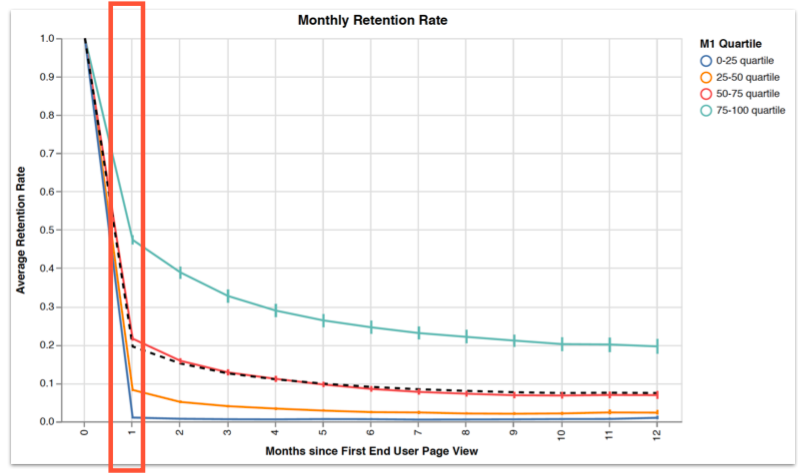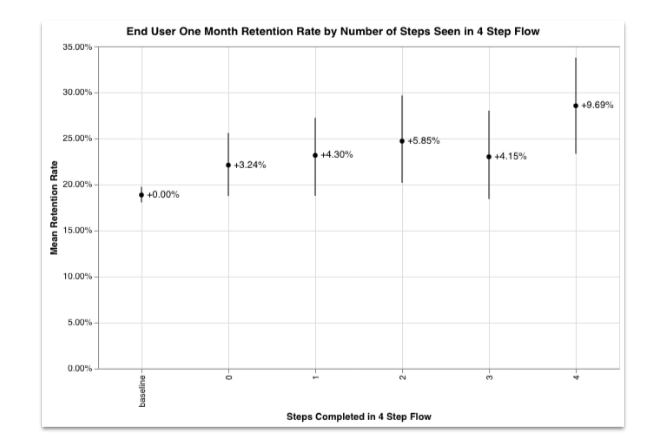The real impact of in-app messaging on end-user retention—learning from our customers' success

.png)

.png)
In the world of product-led SaaS, few KPIs are tracked more closely than retention rate. A SaaS business simply isn’t sustainable if it doesn’t retain its customers. Negative retention—aka churn—is bad. That much is obvious.
The tricky thing about retention is finding a way to isolate variables and understanding what actions really move the needle. What changes will actually result in a retention lift? And what kind of lift should you aim for?
We set out to tackle these questions.
At Appcues, our mission is to help our customers create product experiences that their users love. So we sat down with some raw end-user data to understand how our product impacts our customers’ retention rates. Here's how we did it and what we learned.
There are a number of ways to look at retention, depending on your product and goals. In the simplest terms, retention rate can be calculated as:
Customer retention rate (CRR) = # of customers at end of period / total # of customers
For this analysis, we focused on 2 retention metrics: 30-day and 1-day retention. The first metric is a measure of how many users who signed up for the product came back within 30 days. The second metric, day 1 retention, indicates how strong of a first impression your product made.
Some other ways to define retention within your organization are through behavior-based analytics (how many users are doing X within Y time) or by looking at retention over a longer time period (90-day or 120-day rates).
In order to measure the impact of your strategies on retention, you first need to figure out your baseline metrics. You should also establish a target retention rate to measure progress against a goal.
If setting these benchmarks feels challenging, know that you’re not alone! Ideally, your company will have been tracking retention rates already (hint: if you’re tracking churn, you’re tracking retention—the numbers are the inverse of each other). In that case, that historical data should inform your benchmarks. If you’re lacking this data, or want to supplement your own numbers, use the average retention rates for SaaS companies in your vertical to get a sense of how you stack up.
We took a look at our own data alongside the average 1-day and 30-day retention rates for over 1,000 SaaS businesses (the dotted line below represents this average).

On average, Appcues customers are seeing a 1-day retention rate of 15%. Our top quartile of customers is seeing twice that rate—retaining 30% of new users at the 1-day mark.
Let’s take a look at 30-day retention:

Similarly, we see a trend of the average hovering right around the SaaS average of 20% but top Appcues customers are closer to 50%.
Getting half of your new users to return to your product within a month of signup is tricky, but possible. Let’s talk about how to get there.
Isolating variables and understanding causation is one of the main battles when it comes to improving retention. We were particularly interested in isolating our own product and measuring the impact it had on our customers’ own number. Did seeing Appcues flows make a tangible difference in end-user retention? And was that difference significant?
The answer, it turns out, is yes and yes!
Let’s dig into that a little more: Below is a graph that represents the base 30-day retention rate (roughly 20%) against retention rates of users who start and/or complete Appcues flows.

If end users are completing one step of a 4-step flow, this will increase first-month retention by 3.24% on average. If users are completing the entire 4-step flow, end-user retention rates increase by over 9%.
We can zoom in even further to a specific Appcues customer example:

For this customer, Appcues made a significant impact on 1-day retention rate when comparing users who saw a flow to those who didn’t—0.7% retention versus 25.8%. This makes sense—when users get a contextual, in-app introduction to a product, they have an easier time seeing value, which makes them more likely to return.
Appcues also had a sizable impact on this customer’s 30-day retention rates: Seeing Appcues flows improved 30-day retention by 25%, from 69.8% to an impressive 87.3%. These sorts of results are an important reminder that a better onboarding experience can have long-term, trailing effects on metrics throughout the customer lifecycle.
Think about it: What would a 25% lift in 30-day retention mean to you?
So far, we’ve covered how we are defining retention at Appcues, what retention benchmarks look like across our customer base, and the impact that we see when we isolate Appcues as a variable in our analysis.
What was clear to us when we looked at the data was that, yes, Appcues really does make a difference. That’s obviously good news for us, but it’s also great news for you—whether you’re an Appcues customer or have decided to allocate resources to building, maintaining, and iterating on similar in-app communications in-house.
Because our data shows that users who see Appcues flows within the first 30 days have a 12% higher retention rate on average than those who did not. What could a 12% higher retention rate mean for your own bottom line? Quite a lot.
But don’t take our word for it. We asked around to see what our customers are saying, and retention comes in many different forms. Here’s a quote from Octadesk, a customer aiming to improve their first week retention and conversion with Appcues:
“We offer a 7-day trial. With Appcues, we have been able to 2X our lead conversion. Appcues has had a significant impact on our revenue growth." – Vitor Ferreira, Product Manager, PLG at Octadesk
In-app messaging allows you to communicate with your users in a way that is contextual, timely, and relevant. Whether you choose Appcues or in-house development, you should be prepared to iterate on your experiences quickly and often. Don’t be afraid to experiment with different flows or user segmentation—just be sure you have solid benchmark data in place so you can understand the impact of your changes.
Want to learn more about how Appcues can help you move the needle on your own retention metrics? Give Appcues a try for free.